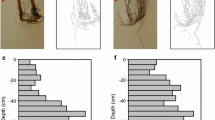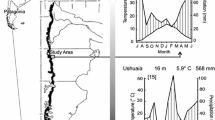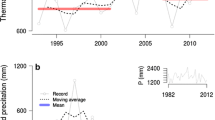Abstract
Competition models including competition for light predict that small plant species preferred by herbivores will be outshaded by taller unpreferred plant species with increasing productivity. When the tall plant species is little grazed by the herbivores, it can easily invade and dominate short vegetation. The tall-growing grass Elymus athericus dominates the highly productive stages of a salt-marsh succession in Schiermonnikoog and is not preferred by the herbivores which occur there, hares and geese. We studied how interspecific competition and herbivory affected performance during early establishment of this species with increasing productivity. Seedlings were planted in the field in a full factorial design, manipulating both interspecific competition and herbivory. The experiment was replicated along a natural productivity gradient. Competition reduced aboveground biomass production and decreased the number of ramets that were produced but did not affect survival of seedlings. The negative effects of competition on seedling performance increased with increasing productivity. In contrast to our expectations, herbivory strongly reduced seedling survival, especially at the unproductive sites and had only small effects on seedling growth. The present study shows that unpreferred tall-growing species cannot easily invade vegetation composed of short preferred species. Grazing by (intermediate-sized) herbivores can prevent establishment at unproductive sites, and increased competition can prevent a rapid invasion of highly productive sites. Herbivores can have a long-lasting impact on vegetation succession by preventing the establishment of tall-growing species, such as E. athericus, in a window of opportunity at young unproductive successional stages.



Similar content being viewed by others

References
Aarssen LW, Epp GA (1990) Neighbour manipulations in natural vegetation: a review. J Veg Sci 1:13–30
Andresen H, Bakker JP, Brongers M, Heydemann B, Irmler U (1990) Long-term changes of salt marsh communities by cattle grazing. Vegetatio 89:137–148
Bakker JP, Bos D, De Vries Y (2003) To graze or not to graze, that is the question. In: Essink K, van Leeuwe M, Kellerman A, Wolff WJ (eds) Proceedings of the 10th International Scientific Wadden Symposium. Ministry of Agriculture, Nature Management and Fisheries, Den Haag, pp 67–88
Bockelmann AC, Reusch T-BH, Bijlsma R, Bakker JP (2003) Habitat differentiation vs. isolation-by-distance: the genetic population structure of Elymus athericus in European salt marshes. Mol Ecol 12:505–515
Bockelmann A-C (2002) Ordinary and successful: the invasion of Elymus athericus in European salt marshes. PhD thesis. University of Groningen, Groningen
Bos D, Bakker JP, De Vries Y, van Lieshout S (2002) Long-term vegetation changes in experimentally grazed and ungrazed back-barrier marshes in the Wadden Sea. Appl Veg Sci 5:45–54
Boudewijn T (1984) The role of digestibility in the selection of spring feeding sites by Brent geese. Wildfowl 35:97–105
Cobb NS, Mopper S, Gehring CA, Caouette M, Christensen KM, Whitham TG (1997) Increased moth herbivory associated with environmental stress of pinyon pine at local and regional levels. Oecologia 109:389–397
Crawley MJ (1993) GLIM for ecologists. Blackwell, Oxford
Dormann CF, Van der Wal R, Bakker JP (2000) Competition and herbivory during salt marsh succession: the importance of forb growth strategy. J Ecol 88:571–583
Gidenne T, Jehl N (1996) Replacement of starch by digestible fibre in the feed for the growing rabbit. 1. Consequences for digestibility and rate of passage. Anim Feed Sci Technol 61:183–192
Goldberg DE, Werner PA (1983) Effects of size of opening in vegetation and litter cover on seedling establishment of goldenrods (Solidago spp). Oecologia 60:149–155
Gross KL, Werner PA (1982) Colonizing abilities of biennial plant species in relation to ground cover: implications for their distributions in a successional sere. Ecology 63:921–931
Grover JP (1995) Competition, herbivory, and enrichment: nutrient-based models for edible and inedible plants. Am Nat 145:746–774
Grubb PJ (2002) The maintenance of species-richness in plant communities: the importance of the regeneration niche. Biol Rev Camb Philos Soc 52:107–145
Huiskes AHL, Koutstaal BP, Herman PMJ, Beeftink WG, Markusse MM, De Munck W (1995) Seed dispersal of halophytes in tidal salt marshes. J Ecol 83:559–567
Huisman J, Grover JP, van der Wal R, Van Andel J (1999) Competition for light, plant species replacement and herbivore abundance along productivity gradients. In: Olff H, Brown VK, Drent RH (eds) Herbivores: between plants and predators. Blackwell, United Kingdom, pp 239–270
Kers AS, Walrecht G, Van Wijnen HJ, Dijkema HS, Bakker JP (1998) Kleidikte, opslibbing en vegetatie Oosterkwelder Schiermonnikoog. In: Eysink WD, et al. (eds) Integrale Bodemdalingstudie Waddenzee 3. Nederlandse Aardolie Maatschappij, Assen, pp 1–36
Langbein J, Hutchings MR, Harris S, Stoate C, Tapper SC, Wray S (1999) Techniques for assessing the abundance of brown hares Lepus europaeus. Mammal Rev 29:93–116
Leendertse PC, Roozen AJM, Rozema J (1997) Long-term changes (1953–1990) in the salt marsh vegetation at the Boschplaat on Terschelling in relation to sedimentation and flooding. Plant Ecol 132:58
Leibold MA (1996) A graphical model of keystone predators in food webs: trophic regulation of abundance, incidence, and diversity patterns in communities. Am Nat 147:784–812
Mulder CPH, Ruess RW (1998) Effects of herbivory on arrowgrass: interactions between geese, neighboring plants, and abiotic factors. Ecol Monogr 68:275–293
Oksanen L, Fretwell SD, Arruda J, Niemelä P (1981) Exploitation ecosystems in gradients of primary productivity. Am Nat 118:240–261
Olff H, De Leeuw J, Bakker JP, Platerink RJ, Van Wijnen HJ, De Munck W (1997) Vegetation succession and herbivory in a salt marsh: changes induced by sea level rise and silt deposition along an elevational gradient. J Ecol 85:799–814
Olff H, Vera FWM, Bokdam J, Bakker ES, Gleichman JM, de Maeyer K, Smit R (1999) Shifting mosaics in grazed woodlands driven by the alternation of plant facilitation and competition. Plant Biol 1:127–137
Owen M (1971) Selection of feeding site by white-fronted geese in winter. J Appl Ecol 8:905–917
Pickett STA, Cadenasso ML, Bartha S (2001) Implications from the Buell-Small succession study for vegetation restoration. Appl Veg Sci 4:41–52
Prins HHT, Ydenberg RC (1985) Vegetation growth and the seasonal habitat shift of the barnacle goose (Branta leucopsis). Oecologia 66:122–125
Prop J, Deerenberg C (1991) Spring staging in Brent geese (Branta bernicla): feeding constraints and the impact of diet on the accumulation of body reserves. Oecologia 87:19–28
Roozen AJM, Westhoff V (1985) A long-term study on salt marsh succession using permanent plots. Vegetatio 61:23–32
Stahl J, Bos D, Loonen MJJE (2002) Foraging along a salinity gradient: the effect of tidal inundation on site choice by dark-bellied Brent geese Branta bernicla and barnacle geese B. leucopsis. Ardea 90:201–212
Tilman D (1985) The resource-ratio hypothesis of plant succession. Am Nat 125:827–852
Van de Koppel J (1997) Trophic interaction in gradients of primary productivity. PhD thesis. University of Groningen, Groningen, pp 47–65
Van de Koppel J, Huisman J, van der Wal R, Olff H (1996) Patterns of herbivory along a productivity gradient: an empirical and theoretical investigation. Ecology 77:736–745
Van der Meijden R, Weeda EJ, Holverda WJ, Hovenkamp PH (1990) Flora van Nederland. Wolters-Noordhoff, Groningen
Van der Wal R, Kunst P, Drent R (1998) Interactions between hare and brent goose in a salt marsh system: evidence for food competition? Oecologia 117:227–234
Van der Wal R, Egas M, van der Veen A, Bakker JP (2000a) Effects of resource competition and herbivory on plant performance along a natural productivity gradient. J Ecol 88:317–330
Van der Wal R, van Lieshout S, Bos D, Drent RH (2000b) Are spring staging brent geese evicted by vegetation succession? Ecography 23:60–69
Van Laar H (1995) De verteringsstrategie van konijnen Oryctolagus cuniculus en van de Europese haas Lepus europaeus. Student report. University of Groningen, Groningen
Van Wijnen HJ, Bakker JP (1997) Nitrogen accumulation and plant species replacement in three salt-marsh systems in the Wadden Sea. J Coast Conserv 3:19–26
Van Wijnen HJ, Bakker JP (2000) Annual nitrogen budget of a temperate coastal barrier salt-marsh system along a productivity gradient at low and high marsh elevation. Perspect Plant Ecol 3:128–141
Van Wijnen HJ, Bakker JP, De Vries Y (1997) Twenty years of salt marsh succession on a Dutch coastal-barrier island. J Coast Conserv 3:9–18
Watt TA, Gibson WD (1988) The effects of sheep grazing on seedling establishment and survival in grassland. Vegetatio 78:91–98
Zar JH (1984) Biostatistical analysis. Prentice Hall, N.J.
Zvereva EL, Kozlov M (2001) Effects of pollution-induced habitat disturbance on the response of willows to simulated herbivory. J Ecol 89:21–30
Acknowledgements
We thank Sip van Wieren, Esther Chang and Thor Veen for useful comments on earlier versions of this manuscript and Bob Jefferies, for comments and suggestions that greatly improved the manuscript. This research was funded by an ALW grant from the Nederlandse Organisatie van Wetenschappelijk Onderzoek. The Vereniging Natuurmonumenten allowed the work in the nature reserve at Schiermonnikoog.
Author information
Authors and Affiliations
Corresponding author
Additional information
Plant nomenclature follows Van der Meijden et al. (1990)
Rights and permissions
About this article
Cite this article
Kuijper, D.P.J., Nijhoff, D.J. & Bakker, J.P. Herbivory and competition slow down invasion of a tall grass along a productivity gradient. Oecologia 141, 452–459 (2004). https://doi.org/10.1007/s00442-004-1664-6
Received:
Accepted:
Published:
Issue Date:
DOI: https://doi.org/10.1007/s00442-004-1664-6



